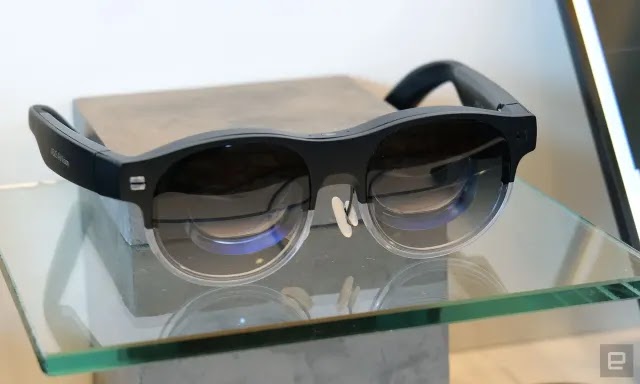At the CES 2024, ASUS unveiled its AirVision M1 glasses, capturing attention as a potential alternative to Apple’s Vision Pro headset. However, upon closer inspection, these glasses emerge as a unique solution more aligned with portable monitors than spatial computing.
Diverging from the interactive AR capabilities of devices like Vision Pro or Xreal’s Air 2 Ultras, the AirVision M1 focuses on expanding your screen space rather than delving into immersive augmented reality experiences. Tethered to a nearby device, these glasses lack support for hand gestures or virtual object recognition.
The primary function of the AirVision M1 is to offer additional screen real estate without the burden of carrying bulky portable monitors.
Equipped with built-in microLED displays boasting full HD resolution, these glasses can project up to six or seven virtual windows or desktops. Users can select from various aspect ratios (16:9, 21:9, 32:9, and more), and the glasses’ three degrees of freedom allow you to fix screens in virtual space or follow your head movements.
During a demo, the AirVision M1, tethered to a laptop, provided an experience akin to a floating desktop positioned six feet in front. Initial virtual displays appeared slightly blurry, but after adjusting and fine-tuning the interpupillary distance, the clarity was impressive. Compared to competitors like Sightful Spacetop, the AirVision M1 offered a larger vertical field of view without requiring additional specialized equipment – a true plug-and-play experience.
Setting up virtual workspaces was a breeze, involving a simple command menu to add new windows or adjust the display size. The glasses also accommodated touchpad and typing interactions seamlessly. ASUS addressed potential distractions with magnetic blinders that create a clean black backdrop when attached to the front.
A standout use case emerged when connecting the AirVisions to an ROG Ally for gaming, providing an expansive virtual screen experience reminiscent of non-VR gaming headsets like Meta Quest 3. This versatility positions the AirVision M1 as a potential travel companion for those seeking a portable monitor alternative.
Crucially, the AirVision M1 stands out in terms of price. While ASUS has yet to provide an official figure, preliminary information suggests a target around $700, a significantly more accessible option compared to Apple’s Vision Pro priced at $3,000. Considering the usual price range of portable monitors ($250 to $400) with less screen space, the AirVision M1’s anticipated price becomes more reasonable.
For those seeking a travel-friendly monitor alternative, the ASUS AirVision M1 glasses, anticipated to hit the market in Q3 2024, present an intriguing option to keep on your radar.






